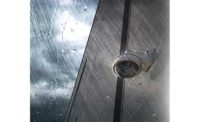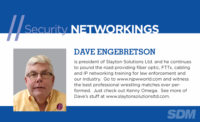Today’s security professionals not only need to understand how criminals think and relate that to the potential vulnerabilities of their clients’ facilities and assets, but they also need to understand the vast number of security products and features designed to aid them in this duty. Many times, a single feature or capability in itself can be confusing and sometimes misleading. One such feature is “camera auto follow.”
If you ask Google for the most popular search terms relating to the topic of “camera auto follow,” you will get a host of options: camera auto follow; PTZ follow; PTZ auto follow; PTZ following; camera auto tracking; auto tracking camera; motion tracking camera, etc. So the question is: What are all of these different varieties and how does one go about asking the right questions to know what you are getting?
A simple definition of “camera auto follow” is the capability to automatically control a PTZ camera’s pan, tilt or zoom in an attempt to keep a specified object centered in the camera’s field-of-view. This is typically achieved via a closed loop control algorithm that continually identifies the target, its current position in the camera’s field-of-view and its trajectory. As the target moves from the center of the image, it automatically adjusts the camera’s physical position using pan, tilt or zoom commands until the target is again centered in the camera’s field-of-view. This typically continues until the target can no longer be detected, a user takes manual control, or after a set time-out period. The feature has considerable value in the design of a security system as it acts as a force multiplier, allowing the first responder to react to a situation without the need to also control the camera.
One may assume that this capability is a function of the camera and you would need to procure new cameras to get this functionality. This is not the case. Camera auto follow capability can physically reside in three places: the camera, an edge device, or a server. Each type of implementation has its pros and cons.
Another subtle but important point is the continued reference to “controlling pan, tilt or zoom.” Often the algorithm only controls pan and tilt. One of the reasons for this is the fact that the zoom function for many cameras can be slow. This can be due to mechanical limitations, but it also can be due to command timing, whereby a zoom command may not be able to be executed concurrently with a pan and tilt command. Whatever the reason, a slow zoom can provide time for the target to move out of the field-of-view, so when the zoom is complete there is no object to detect. Another complexity of zoom can be the camera’s ability to remain focused during the zoom event. This period of unfocused video can also cause issues with detection, creating the same scenario where the target moves during the zoom action and there is no object present when the zoom action is completed.
In some cases, there may not be any ramifications of not having zoom control with the camera auto follow. If your client is monitoring a fairly small area, then there may not be a need to have this zoom feature. The camera can track the object around the general area, with a good view of the target. The downside is eventually the object may move far enough away that it will be too small to be of viewing value, or have too few pixels for the algorithm’s detection software to recognize. As you start to move to more distant ranges, the ability to utilize your camera’s zoom does have significant value. If you intend for your camera auto follow to perform at varying distances, then it is important research its zoom capability.
Single Camera Vs. Multiple Cameras
Another common misunderstanding in the world of camera auto follow is the idea of single- or multiple-camera follow. Each of these can be further confused by the idea of camera handoff. To further clarify our definition of camera auto follow: The capability to automatically control a PTZ camera’s pan, tilt or zoom in an attempt to keep a specified object centered in the camera’s field-ofview, using only the video information provided by that same PTZ camera.
This differentiates it from some forms of camera auto follow whereby the PTZ camera requires that a fixed camera continually detects and provides location information for the target being tracked. By default, the fixed camera needs to have geospatial awareness, meaning it can translate the object detected in the fixed camera video to latitude/longitude information, which then can be presented to the PTZ camera performing the auto follow, which also will require this geospatial capability. Geospatial is a good thing and it provides many other advantages to a perimeter security system, but this scenario has limitations, including the need to have at least one fixed and one PTZ camera, the need to have geospatial capability on both cameras, and the understanding that once the target leaves the fixed camera’s field-of-view, the PTZ camera with auto-follow will no longer be able to follow the target.
Detection Types
In terms of detection, some algorithms follow pixels, while other follow classified targets. Why does this make a difference? A classic scenario is what happens when the camera is following a person, and then a car happens by. Pixel-based detection most likely will change course and follow the vehicle, as it is a moving target with many more pixels. Following algorithms based on classification will follow the object by type; so if the auto-follow was initiated for a “human,” when a “car” is introduced to the scene it will attempt to stay with the object classified as “human.”
Another valuable feature related to camera auto follow is how the feature gets invoked. This typically falls into a few categories: always on, manual by scene, manual by target, and slew to cue.
Always on/off is straightforward; auto follow is either on or off and triggers within a certain area of the scene of the auto-follow camera.
Manual by scene means the operator, or third-party sensor, invokes the camera auto follow based on the current scene. Upon enabling this function, the detection portion of the software evaluates the scene and starts to follow the object that is typically closest to the center of the view. Manual by scene also can involve a camera preset, where a third-party sensor trips and directs the camera to a preset scene.
Manual by target is the ability for the user to manually invoke auto follow and then select the specific target of interest by clicking directly on the target within the video feed. This provides benefits in situations where there may be more than one target in the scene and the operator wants to select a specific one to follow.
Slew to cue, similar to manual by target, involves the initial steering of the camera to an exact location, versus to a scene. Once the camera has redirected itself so it is looking at the correct “cue,” which in this case is a latitude, longitude and elevation, it uses this exact reference point to identify which object is the target of interest and begins its automatic follow. This proves very valuable for views with multiple targets, or a scene that may cover a very large physical area.
Camera auto follow is a very powerful feature to consider as an addition to your security offerings. The ability to track an intrusion hands-free allows security personnel freedom to perform other tasks in support of the event. The trick is cutting through the various terms being used so you can understand the options available to you when selecting the best camera auto follow for your clients’ need. — Contributed by Eric Olson, vice president of marketing at PureTech Systems, www.puretechsystems.com. This article was adapted from a white paper, “31 Flavors of Camera Auto Follow,” published by PureTech Systems.



